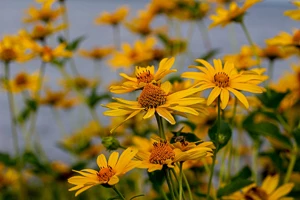Heliopsis
Heliopsis, commonly known as False Sunflower, is a perennial flowering plant native to dry prairies in North and South America. It’s valued for its bright, sunflower-like blooms and its robustness.
Size: Typically, Heliopsis exhibits an upright, branching growth habit and can reach sizes of 3 to 6 feet tall (90-180 cm) and 2 to 4 feet wide (60-120 cm), depending on the variety. It forms clumps of stiff stems and toothed, ovate leaves.
Flowers: The flowers of Heliopsis resemble small sunflowers, with yellow to orange-yellow petals and a darker central disk. These cheerful blooms appear from early summer to fall, offering long-lasting color in the garden.
Hardiness: Heliopsis is hardy in USDA zones 3-9, tolerating a wide range of soil conditions, including poor soils, and is drought-tolerant once established. It prefers full sun but can tolerate light shade.
Pollinators: The showy flowers of Heliopsis are attractive to a variety of pollinators, including bees, butterflies, and birds.
Uses: Heliopsis makes a vibrant addition to borders and wildlife gardens, and its tall stature makes it suitable for the back of a flower bed. It’s also useful for naturalizing and in wildflower meadows. Its flowers also make excellent cut flowers.
Its long blooming season, coupled with its low maintenance needs, make it a popular choice for gardeners. It’s a reliable, hardy, and cheerful perennial that brings brightness to any garden.

